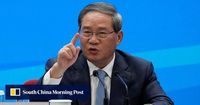On September 25, 2025, the bustling city of New York played host to a pivotal moment in international relations, as Chinese Premier Li Qiang met with a diverse group of U.S. business, academic, and civic leaders on the sidelines of the 80th session of the United Nations General Assembly. The meeting, which drew representatives from influential organizations such as the U.S.-China Business Council, the National Committee on U.S.-China Relations, the U.S. Chamber of Commerce, and the Council on Foreign Relations, took place against a backdrop of heightened tensions and shifting alliances among the world’s largest economies.
Li Qiang, leading China’s delegation in place of President Xi Jinping, wasted no time in addressing the current state of affairs. According to Xinhua, he emphasized, “China and the United States need to find the right way to get along in the new era.” Calling the relationship between the two nations “the most important bilateral relations in the world,” Li underscored the necessity for both sides to “respect each other, coexist in peace, pursue win-win cooperation, and achieve common prosperity through mutual success.”
Li’s remarks, echoed in reporting by the Associated Press, struck a chord with the roughly 20 American business executives present. He told the gathering, “The China-U.S. relation is the most important bilateral partnership in the world. Its steady development requires our two governments to work in the same direction.” The message was clear: at a time when trade, technology, and geopolitical disputes threaten to upend decades of engagement, both sides must make conscious efforts to maintain dialogue and forge a path forward.
The context for this meeting was anything but simple. Since the start of President Donald Trump’s second term, relations between Washington and Beijing have been strained by a series of economic and political flashpoints. As reported by the South China Morning Post, a tit-for-tat trade war erupted early in Trump’s new term, with his administration imposing tariffs as steep as 145 percent on all Chinese imports. Although a temporary truce later reduced tariffs to around 30 percent, the specter of further escalation loomed, with a U.S.-imposed deadline of November 10 threatening to reignite hostilities.
Trade wasn’t the only source of friction. Washington also tightened restrictions on Chinese investments in the U.S., limited Chinese student visas, and slapped additional penalties on China over its manufacture of ingredients used in producing illegal fentanyl. These measures, combined with ongoing disputes over technology, minerals, and the future of platforms like TikTok, have left the bilateral relationship at one of its lowest points in recent memory.
Yet, amid these challenges, Li Qiang projected confidence in China’s economic resilience and its ability to offer opportunities for global businesses, including those from the U.S. He asserted, according to Xinhua, that “China has the confidence and ability to maintain stable and healthy economic development, and create more opportunities for enterprises from all over the world, including U.S. companies.” He pledged that China would continue to honor its commitments, expand opening up, relax market access, and increase imports to support foreign businesses. “No matter how the external environment changes, China will do its utmost to provide greater certainty for the development of foreign businesses,” Li added.
Li’s call for cooperation was not limited to the economic sphere. He stressed the importance of grassroots connections, stating, “The foundation of the China-U.S. relationship lies in grassroots connections, and its sound development requires the joint efforts of the people from both countries.” He encouraged U.S. participants to take positive actions to enhance mutual understanding, expand practical cooperation, and promote friendship between the two nations.
The American side responded with cautious optimism. According to Xinhua, U.S. participants at the meeting acknowledged China’s “admirable achievements in economic growth, technological innovation, social development and other fields in recent years.” They expressed hope that the two countries would maintain high-level exchanges, expand dialogues, strengthen mutually beneficial cooperation, and enhance people-to-people exchanges to develop long-term and stable U.S.-China relations. The U.S. business community, in particular, voiced optimism about China’s economic prospects and a willingness to continue expanding investment in China, viewing themselves as a bridge to promote bilateral cooperation and mutual understanding.
Stephen Orlins, president of the National Committee on U.S.-China Relations, summed up the sentiment in a statement reported by the Associated Press: “It is essential to American interests that business leaders and policy experts have the opportunity to discuss key issues, address concerns and maintain working relationships with Chinese leaders.”
But the challenges facing the world’s two largest economies are not theirs alone. As Reuters reported, Premier Li Qiang also met with European Commission President Ursula von der Leyen in New York on September 24, 2025. Their discussions centered on the impact of President Trump’s tariffs, which have squeezed both Chinese and European exports. Von der Leyen highlighted Europe’s concerns about export controls, market access, and industrial overcapacity, while expressing appreciation for China’s willingness to engage in a spirit of mutual understanding. She also urged China to use its influence to help bring an end to the war in Ukraine and encourage Russia to negotiate peace, demonstrating the complex web of strategic and economic issues that now define global diplomacy.
Li Qiang, for his part, expressed hope that China and the EU could “uphold the original aspirations of establishing diplomatic relations” and that the EU would “maintain open trade and investment markets.” The Chinese foreign ministry added, “As two important poles in the world, China and the EU should demonstrate responsibility and maintain strategic independence.”
Meanwhile, the U.S. continued to press its own agenda. On September 25, 2025, President Trump signed an executive order addressing the sale of Chinese-owned TikTok’s U.S. operations, a move intended to satisfy national security requirements in a 2024 law. This action added yet another layer to the already complex relationship between Washington and Beijing.
With so many moving parts—trade wars, technology disputes, geopolitical maneuvering, and the ever-present risk of misunderstanding—it’s no wonder that both Chinese and American leaders are urging dialogue and cooperation. As Li Qiang told his American counterparts, “The actions that you take are crucial.” Whether these calls for partnership will translate into concrete improvements remains to be seen, but for now, the world is watching as the U.S. and China try to find common ground amid uncertainty and change.
In a year marked by economic headwinds and diplomatic standoffs, the hope for a steadier, more constructive relationship between the U.S. and China hinges on the willingness of leaders, businesses, and citizens alike to keep the lines of communication open and to work, as Li put it, in the same direction.


